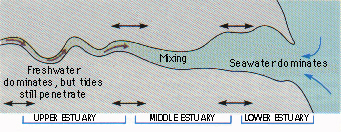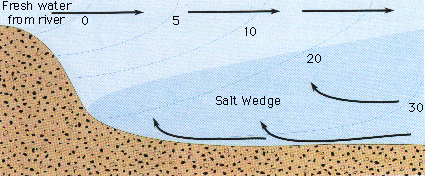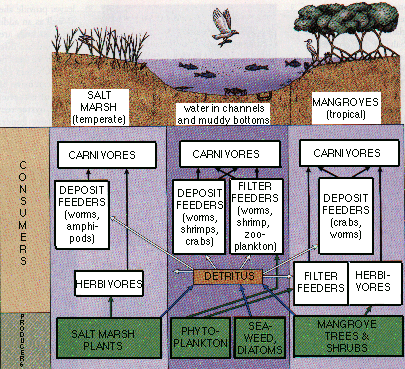Coasts II: Types (continued)
6. estuaries
- are semi-enclosed coastal bodies of water where freshwater rivers meet the sea; freshwater and seawater mix, creating a unique and complex ecosystem with have 3 sections:
- a marine or lower estuary that has a free connection to the sea with salinities that are ocean-like (30-35 ppt -- called a polyhaline zone);
- a middle estuary subject to strong salt and freshwater mixing (salinities of ~15 ppt -- called the mesohaline zone); and
- an upper or fluvial estuary, characterized by freshwater, but subject to daily tidal action (salinities ~0-5 ppt -- called the oligohaline zone)

- some of the most biologically productive ecosystems on earth due to abundant organic detritus (that provides nutrients to other organisms)
- unstable due to many physical, geological, chemical, and biological factors
- size and shape is influenced by the amount of freshwater entering the estuary and by the geological history of the area that occurred during the last glacial maximum
- formed during last interglacial stage when sea level rose 120 m from 15,000 years ago to 5,000 years ago; most common on coasts with broad, flat continental margins
- coastal plain estuaries: are broad, shallow embayments formed from deeper V-shaped channels as sea level rose and flooded river mouths (ex: Chesapeake Bay, Delaware Bay, Charleston Harbor); generally not deeper than 20 m
- drowned river valley type of estuary: formed by rising sea level flooding valleys of coastal drainage basins; gradually modified as wave erosion cut away existing shorelines; siltation creates others by building mudflats
- bar-built estuaries/lagoons: formed as near-shore sand and mud are moved by coastal wave action to build an obstruction, or bar, in front of a coastal area fed by one or more coastal streams or rivers (restricted mouth)
- subsided or tectonic estuaries: created when the land sank as a result of movements of the crust (ex: San Francisco Bay)
- fjords: formed from glacial carving into coastal land forms; are deeper than other types of estuaries; have shallow sills at their mouths that partially block the inflow of sea water
- physical characteristics:
- salinity: fluctuates dramatically both from place to place and from time to time; salinity decreases moving upstream towards freshwater source; it moves as a salt wedge on bottom, as freshwater is less dense, and does so with the tides (back and forth) -- forms a stable halocline and the two water masses do not mix well
-

- however, can also have partially mixed estuaries where rivers discharge into sea with a moderate tidal range; get current shear at freshwater/saltwater interface plus sheer at bed which causes turbulence that mixes seawater upwards and freshwater downwards; this in turn causes residual currents
- finally can get well mixed estuaries where tidal range is high and the tidal currents are stronger than the river currents; salinity here will not vary greatly with depth
- tides: because most estuaries are long and narrow, the tide just doesn't rise, it rushes in, creating strong tidal currents
- temperature: there is usually a smaller volume of water and larger surface area; thus the water is heated and cooled more rapidly (except for fjords)
- turbidity: highly turbid except at the mouth of the estuary where full seawater is encountered; thus get a reduction in photosynthesis due to less penetration of light
- substrate: is usually soft mud (combination of silt and clay); often are anoxic below the first centimeters due to bacteria using up the oxygen
- are the tropical and subtropical equivalent of salt marshes, occurring when humid, tropical mud flats are colonized by mangrove trees and shrubs that have root systems that trap muds and are highly salt-tolerant
- mangrove plants are shallow-rooted with roots that spread widely or have peculiar prop roots that stem from the trunk or branches; roots send up pneumatophores, extensions to the surface of the substrate that allow the roots to receive oxygen in the otherwise anoxic mud in which the trees grow
- dominant genera include Rhizophora, Avicennia, and Bruguiera and all share the following features:
- they are salt tolerant and ecologically restricted to tidal swamps
- they have both aerial and shallow roots that intertwine and spread widely over muddy substrates in a huge tangle (the substrate is oxygen poor so the aerial roots allow the plant to obtain oxygen directly from the atmosphere)
- they have special physiological adaptations that prevent salt from entering their tissues or that allow them to excrete salt
- many are viviparous -- they produce seeds that germinate on the tree; young plants drop from the tree and float away from the parent plant
- can only grow on shores that are sheltered from wave action, so water motion is minimal
- because of minimal water motion and the root structures, sediment tends to accumulate in mangrove forests and they are a major producer of new coastal land at the expense of the sea; thus as one progresses through a mangrove association from seaward to landward size, will see a progressive change from marine to terrestrial conditions
- display both a horizontal zonation pattern consisting of a series of tree species followed by shrubs and a vertical zonation pattern consisting of:
- above-tide forest is the zone formed by the trunks and leaf canopy of the mangroves; is an arboreal environment inhabited by terrestrial species (birds, bats, lizards, snakes, snails, land crabs, spiders, insects, mangrove crabs)
- intertidal swamp has a variety of microhabitats and includes the mangrove roots, mudflats, mudbanks, etc.; inhabited by amphipods, polychaetes, isopods, barnacles, oysters, periwinkles, nematodes, fiddler crabs, sea cucumber, crabs, mudskippers, shrimp
- subtidal zone has sediments of fine-grained mud with high organic content; sand patches can be present as well; subtidal mangrove roots support a rich epiflora/fauna of algae, sponges, tunicates, anemones, hydroids, and bryozoans; turtle grass may be the dominant plant on subtidal mud flats; other inhabitants include fish, crabs, lobsters, shrimp, worms, crocodiles, and Ridley sea turtles
- are subject to natural mortality via hurricanes and typhoons and recovery time after such events is on the order of 20 to 25 years; isopods can also destroy these forests by boring into the roots which will eventually cause the prop roots to break and the trees will fall into the water and die
